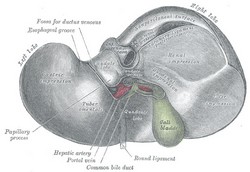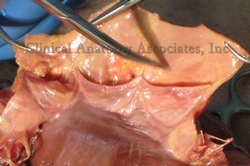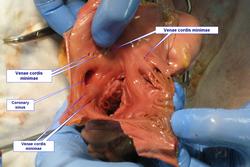
Medical Terminology Daily (MTD) is a blog sponsored by Clinical Anatomy Associates, Inc. as a service to the medical community. We post anatomical, medical or surgical terms, their meaning and usage, as well as biographical notes on anatomists, surgeons, and researchers through the ages. Be warned that some of the images used depict human anatomical specimens.
You are welcome to submit questions and suggestions using our "Contact Us" form. The information on this blog follows the terms on our "Privacy and Security Statement" and cannot be construed as medical guidance or instructions for treatment.
We have 619 guests online

Jean George Bachmann
(1877 – 1959)
French physician–physiologist whose experimental work in the early twentieth century provided the first clear functional description of a preferential interatrial conduction pathway. This structure, eponymically named “Bachmann’s bundle”, plays a central role in normal atrial activation and in the pathophysiology of interatrial block and atrial arrhythmias.
As a young man, Bachmann served as a merchant sailor, crossing the Atlantic multiple times. He emigrated to the United States in 1902 and earned his medical degree at the top of his class from Jefferson Medical College in Philadelphia in 1907. He stayed at this Medical College as a demonstrator and physiologist. In 1910, he joined Emory University in Atlanta. Between 1917 -1918 he served as a medical officer in the US Army. He retired from Emory in 1947 and continued his private medical practice until his death in 1959.
On the personal side, Bachmann was a man of many talents: a polyglot, he was fluent in German, French, Spanish and English. He was a chef in his own right and occasionally worked as a chef in international hotels. In fact, he paid his tuition at Jefferson Medical College, working both as a chef and as a language tutor.
The intrinsic cardiac conduction system was a major focus of cardiovascular research in the late nineteenth and early twentieth centuries. The atrioventricular (AV) node was discovered and described by Sunao Tawara and Karl Albert Aschoff in 1906, and the sinoatrial node by Arthur Keith and Martin Flack in 1907.
While the connections that distribute the electrical impulse from the AV node to the ventricles were known through the works of Wilhelm His Jr, in 1893 and Jan Evangelista Purkinje in 1839, the mechanism by which electrical impulses spread between the atria remained uncertain.
In 1916 Bachmann published a paper titled “The Inter-Auricular Time Interval” in the American Journal of Physiology. Bachmann measured activation times between the right and left atria and demonstrated that interruption of a distinct anterior interatrial muscular band resulted in delayed left atrial activation. He concluded that this band constituted the principal route for rapid interatrial conduction.
Subsequent anatomical and electrophysiological studies confirmed the importance of the structure described by Bachmann, which came to bear his name. Bachmann’s bundle is now recognized as a key determinant of atrial activation patterns, and its dysfunction is associated with interatrial block, atrial fibrillation, and abnormal P-wave morphology. His work remains foundational in both basic cardiac anatomy and clinical electrophysiology.
Sources and references
1. Bachmann G. “The inter-auricular time interval”. Am J Physiol. 1916;41:309–320.
2. Hurst JW. “Profiles in Cardiology: Jean George Bachmann (1877–1959)”. Clin Cardiol. 1987;10:185–187.
3. Lemery R, Guiraudon G, Veinot JP. “Anatomic description of Bachmann’s bundle and its relation to the atrial septum”. Am J Cardiol. 2003;91:148–152.
4. "Remembering the canonical discoverers of the core components of the mammalian cardiac conduction system: Keith and Flack, Aschoff and Tawara, His, and Purkinje" Icilio Cavero and Henry Holzgrefe Advances in Physiology Education 2022 46:4, 549-579.
5. Knol WG, de Vos CB, Crijns HJGM, et al. “The Bachmann bundle and interatrial conduction” Heart Rhythm. 2019;16:127–133.
6. “Iatrogenic biatrial flutter. The role of the Bachmann’s bundle” Constán E.; García F., Linde, A.. Complejo Hospitalario de Jaén, Jaén. Spain
7. Keith A, Flack M. The form and nature of the muscular connections between the primary divisions of the vertebrate heart. J Anat Physiol 41: 172–189, 1907.
"Clinical Anatomy Associates, Inc., and the contributors of "Medical Terminology Daily" wish to thank all individuals who donate their bodies and tissues for the advancement of education and research”.
Click here for more information
- Details
The medical term [septic] arises from the Greek word [σηπτικός] (siptikós) which means “rotting”, “decaying”, or "putrefact". It was later adopted in Latin as the word we use today: [septic].
Septic describes a condition of infection of the tissues or wound contamination by any means, including bacteria. When blood is contaminated or infected, we refer to it as [septicemia]
A medical terminology note: Although it would seem that the root terms for septal and septic are the same, they are not. In the first one it is [-sept-], while in the second one the whole word [septic] is also the root term.
Then, if the above is true, why do we say [sepsis]? It is because the base of the Greek word [σηπτικός] (siptikós) is [σήψις] (sipsis) meaning “to rot”
Note: The links to Google Translate include an icon that will allow you to hear the pronunciation of the word.
- Details
The root term [-sept-] arises from the Latin word [septum] which means “partition”, referring to a wall or division between areas or compartments. The addition of the adjectival suffix [-al] gives us the word [septal], meaning “pertaining to a septum”. The plural for [septum] is [septa]
In human anatomy the term is used in:
- Nasal septum: The osteocartilaginous division between both sides of the nose
- Interatrial septum: The wall or division between the atria of the heart
- Interventricular septum: The partition between the heart ventricles
- Septum pellucidum: A membranous separation between the lateral ventricles of the brain
- Intermuscular septa: There are several fibrous septa between the muscles in both the upper and lower extremities.
There are other septa in the human body not listed here.
Interestingly, the Greek counterpart of the Latin term [septum] is [διάφραγμα] (diáfragma) meaning “diaphragm”.
Note: The links to Google Translate include an icon that will allow you to hear the pronunciation of the word.
- Details
The root term [-hepat-] arises from the Greek word [ηπαρ] (ipar) which means “liver”. It is used in many medical terms:
- Hepatic: The adjectival suffix [-ic] means “pertaining to”. Pertaining to the liver, as in “common hepatic artery”
- Hepatitis: The suffix [-itis] means “inflammation” or “infection”. Inflammation of the liver
- Hepatectomy: The suffix [-ectomy] means “removal of”. Removal of the liver
- Hepatomegaly: The suffix [-(o)megaly] means “enlargement”. An enlarged liver
Note: The links to Google Translate include an icon that will allow you to hear the pronunciation of the word.
Image in Public Domain, by Henry Vandyke Carter, MD - Gray's Anatomy.
- Details
[UPDATED] The term [semilunar] means "half moon"; [luna] is Latin for "moon"). The term [semilunar valve] is a generic term used to describe both the pulmonary and aortic valves found at the exit of the right and left ventricle respectively. These valves are also called the "sigmoid valves"
Each valve is formed by three half-moon shaped leaflets (see accompanying image). Each leaftlet "hangs" loosely towards the lumen of the vessel, creating a space between the leaflet and the wall of the vessel. Each one of these spaces is called a "sinus of Valsalva".
The point where two leaflets meet is called a "commissure".
Image property of:CAA.Inc.
- Details
The term [semilunar] is composed of the prefix [semi-] meaning "half", the root term [-lun-] which arises from the Latin word [luna] meaning "moon", and the adjectival suffix [-ar] meaning "pertaining to".
It is used to describe semicircular structures such as the leaflets or cusps that form both the both the pulmonary and aortic valves, Because of the shape of these leaflets these valves are also called "semilunar valves".
Image property of: CAA.Inc.
- Details
The venae cordis minimae, or smallest cardiac veins are known eponimically as the "veins of Thebesius". These "veins" are open, valveless communication channels between the heart chambers and the subendocardial vascular plexus. The Thebesian veins are most prevalent in the right atrium, although they have been described in all four heart chambers.
Studies have been conducted that demonstrate that these channels communicate with both arteries and veins1. This being so, the Thebesian "veins" are not true veins, nor arteries. It has been argued that when performing a transmural myocardial revacularization procedure using lasers, the surgeon is only copying what nature already has built in the heart, the Thebesian veins.
The actual opening of the venae cordis minimae into the chambers of the heart are called the foramina Thebesii. The image shows an human heart dissection, where the right atrium has been opened and the foramina Thebesiiclearly seen. For a larger depiction, click on the image.
1. "Anatomy and clinical significance of ventricular Thebesian veins" Ansary A. Clin Anat 2001; 14(2) 102-10




